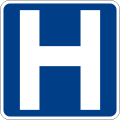Road signs in the United States
_Adoption.svg.png)
In the United States, road signs are, for the most part, standardized by federal regulations, most notably in the Manual on Uniform Traffic Control Devices (MUTCD) and its companion volume the Standard Highway Signs (SHS). There are no plans for adopting the Vienna Convention on Road Signs and Signals standards.
Twenty-three states along with the District of Columbia and Puerto Rico use the manual without any alterations, 20 states have adopted it in conjunction with a supplemental volume, and seven states have a state version in substantial conformance to the MUTCD.[1] There are also localized versions that are used in large cities such as New York City which use a naming system compatible with the MUTCD and/or state supplement. The MUTCD and SHS establish seven general categories of signs for road and highway use[2] (all signs from national MUTCD, unless noted).
Regulatory
Regulatory signs give instructions to motorists, pedestrians, and cyclists. Signs such as stop, no parking, no turns, and yield are considered regulatory signs. Some have special shapes, such as the octagon for the stop sign and the X shape for railroad crossings. Some signs can be localized, such as no parking, and some are only found in state and local jurisdictions as they are based on state or local laws, such as New York City's "Don't Block the Box" signs. These signs are in the R series of signs in the MUTCD and typically in the R series in most state supplements or state MUTCDs.
R1 Series: Stop and Yield
The MUTCD's R1 series of is for stop and yield. As not all situations are covered, several states have their own standards in addition to the MUTCD.
- Stop and Yield
-

Stop
-
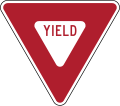
Yield (Give Way)
-

All way plate
-

Yield to pedestrians,
New York City -

State law Yield to pedestrians in crosswalk
-

State law stop for pedestrians in crosswalk
-

4-way plate
R2 Series: Speed Limit
The MUTCD's R2 series is for speed limit signs. Some state supplements and state MUTCDs place various speed limit signs in other series. As all situations are not covered, several states have their own standards in addition to the MUTCD. Speed limits in the United States are in miles per hour. Metric speed limit signs in kilometers per hour are authorized but extremely rare, usually seen near the borders with Canada and Mexico, both of which use the metric system. Many states however disallow the use of metric signs on state-maintained roads, increasing the rarity of such signs.
- Speed Limit Signs
-
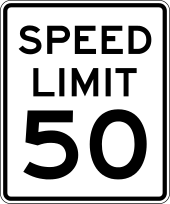
R2-1: Speed limit
-

R2-2: Trucks speed limit
-
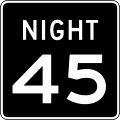
R2-3: Nighttime speed limit
-

R2-4: Minimum speed limit
-

Metric R2-1
-

Metric R2-2
-

Metric R2-3
-

Metric R2-4
-

R2-1T: Texas
-

End speed limit: Delaware
-

State speed limit: New York (can also read "area", "city", "town", or "village")
-

End speed limit: New York
-

Bridge speed limit: Minnesota
R3 Series: Lane Usage and Turns
The MUTCD's R3 series of signs is for lane usage and turn signs. As all situations are not covered, several states have their own standards in addition to the MUTCD.
- Lane Usage and Turns Signs
-

Turn only lanes
-

No straight through
-

No Right Turn
-

No Left Turn
-

No Left Turn Across Tracks
-

No Turns
-

No U-turn
-

No Left or U-turn
-
.svg.png)
No U-turn - left turn on green arrow, California
-

Bike lane
-

Bike lane, bikes only, New York City
-

HOV 2+ only 2 or more persons per vehicle
R4 Series: Regulation of Movement
The MUTCD's R4 series of signs is for the regulation of movement signs. As all situations are not covered, several states have their own standards in addition to the MUTCD.
- Regulation of Movement Signs
-

Passing zone ends
-

Passing zone begins
-

-

-

-

-

Keep right
-

Keep right
-

Keep right
-

Keep right
-

Keep left
-

Keep left
-

Keep left
-

Keep left
-

-

-
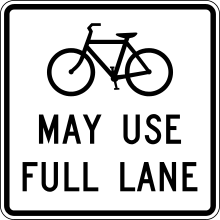
Cyclists may use full lane
-

-

-

-

-

-

-

California
-

Delaware
-

Delaware
-

Delaware
-

Indiana
R5 Series: Exclusionary
The MUTCD's R5 series of signs is for exclusionary signs. As all situations are not covered, several states have their own standards in addition to the MUTCD. The most common of these signs is the do not enter sign.
- Exclusionary Signs
-

Do Not Enter
-

No Entre, Puerto Rico
-

Wrong Way
-

Bicycle Wrong Way
-

Bike Path, No Automobiles, New York City
-

No Large Trucks
-

No motorized Vehicles
-

No Lugged Vehicles
-

No Bicycles
-

No Nonmotorized Traffic
-

No Motorcycles
-

No Pedestrian Crossing, Bicycles, or Motorcycles
-

No Unauthorized Vehicles
R6 Series: One Way and Divided Highway
The MUTCD's R6 series of signs is for one way and divided highway signs. As all situations are not covered, several states have their own standards in addition to the MUTCD. The most common of these signs is the one way sign.
- One Way and Divided Highway
-

One Way
-

Transito (one way), Puerto Rico
-

One Way, alternate
-

Divided Highway
-

Chevron roundabout directional
R7 Series: Parking
The MUTCD allows for three types of parking signs, permissive, no parking, and no standing. However, in most states, there is an additional more restrictive one, no stopping. These signs are found in the R7 series of signs in the MUTCD. As all situations are not covered, several states and local governments have their own standards in addition to the MUTCD.
Permissive Parking
These types of signs allow for parking for either an unlimited or varied amount of time. These types are often used in conjunction with parking meters and parking permits. These signs are specified by the MUTCD to be green on white. Local variations do occur with additional information and slightly different designs.
- Permissive Parking
-

Parking with time restrictions
-

Parking with time restrictions, California
-

Parking with time restrictions, New York City
-

Parking with time and permit restrictions, Seattle
-

Parking with time and permit restrictions, San Francisco
-

2 hour parking all roads Town of Hempstead, New York State
-

Parking with time restrictions, Maryland
-

Parking fee station
-

Reserved parking (wheelchair)
No Parking
No parking signs indicate that loading or unloading there while temporarily stopped is permitted, but parking is not.[3] Some no parking signs display time restrictions, while others are permanent restrictions. There are also temporary versions of the signs, often of similar design to the permanent ones. These signs are specified by the MUTCD to be red on white, although local variations do occur.
- No Parking
-

No parking
-

No parking, California
-

No parking, New York
-

No parking, Pennsylvania, Texas
-

No parking with restrictions and localized, New York City
-

Don't even think of parking here, New York City
-

No parking tow zone, Chicago
-

No parking bus stop
-

Tow Away Zone
No Standing
No standing signs indicate that stopping temporarily to load or unload passengers is allowed, while parking is not allowed.[3] As with no parking signs, some restrictions displayed on the signs are permanent and some are time based. The signs are also specified by the MUTCD to be red on white, but local variations exist.
- No Standing
-

No standing any time
-

No standing any time, New York State
-

No standing any time, New York City
-

No standing cars towed away, Baltimore
-

No standing bus stop, Philadelphia
-

No standing, bus stop with bus route, New York City
-

No standing with time restrictions, Washington, D.C.
-

No standing with time restrictions, New York City
No Stopping
No stopping signs indicate that stopping is only allowed in order to obey a traffic sign, signal, traffic agent, police officer, or to avoid conflicts with other vehicles.[3] These are the most restrictive of the parking signs. They are typically red on white.
- No Stopping
-

No stopping any time, New York State
-

No stopping any time, New York City
-

No stopping any time, Philadelphia
-
.svg.png)
No stopping any time, California
-

No stopping anytime tow away, San Francisco
-

No stops tow away zone, Seattle
-

No stopping with time restrictions, New York State
-

No standing except delivery trucks time restricted, New York City
R8 Series: Parking and Emergency Restrictions
The MUTCD's R8 series of signs is for parking restriction and emergency restriction signs. As all situations are not covered, several states have their own standards in addition to the MUTCD.
- Parking and Emergency Restrictions
-

No parking on pavement
-

No parking
-

Exception of Sundays and holidays
-

On tracks plaque
-

Except on shoulder plaque
-

Loading zone
-

Stop here on red
-

Stop here when flashing
R9 Series: Bicycles and Pedestrians
The MUTCD's R9 series of signs is for bicycle and pedestrian signs. As all situations are not covered, several states have their own standards in addition to the MUTCD.
- Bicycle and Pedestrian Signs
-

Walk on left facing traffic
-

Cross only at cross walks
-

No pedestrian crossing
-

No rollerblading
-

No hitch hiking
-

Crosswalk signal instructions
-

Bicycles left pedestrians right
-

State law stop for stopped school bus, New York
-

Sidewalk Closed Use Other Side
-

No horseback riding
R10 Series: Traffic Signal
The MUTCD's R10 series of signs is for traffic signal related signs. As all situations are not covered, several states have their own standards in addition to the MUTCD.
- Traffic Signal Signs
-
.svg.png)
Turning vehicles yield to pedestrians
-

Traffic signal photo enforced, California, Louisiana, Texas, Florida
-

Red light photo violation fine sign, California
-

Stop here on red, Pennsylvania, Florida
-

No turn on red arrow, Maryland
-

Bicycles to request green wait on line
R11 Series: Road Closed
The MUTCD's R11 series of signs is for road closure related signs. As all situations are not covered, several states have their own standards in addition to the MUTCD.
- Road Closed Signs
-

Road Closed
-

Road Closed Ahead
-

Bridge Out Ahead
R12 Series: Weight Limits
The MUTCD's R12 series of signs is for weight limit related signs. As all situations are not covered, several states have their own standards in addition to the MUTCD.
- Weight Limits Signs
-

Weight Limit
-

Axle Weight Limit
-

Weight Limit with per axle and gross
-

Weight Limit with truck symbols
R13 Series: Weigh Stations
The MUTCD's R13 series of signs is for weigh station related signs. As all situations are not covered, several states have their own standards in addition to the MUTCD.
-

Weigh station sign
-

Weigh station next right sign
-

Weigh station sign with right exit arrow
R14 Series: Truck Routes
The MUTCD's R14 series of signs is for truck route related signs. As all situations are not covered, several states have their own standards in addition to the MUTCD.
-

Truck Route sign
-

Hazardous Material Route
-

Hazardous Material Prohibited
-

National Network Route
-

National Network Prohibited
R15 Series: Rail and Light Rail
The MUTCD's R15 series of signs is for rail and light rail related signs. As all situations are not covered, several states have their own standards in addition to the MUTCD.
- Rail and Light Rail Signs
-

Railroad crossing (crossbuck)
-
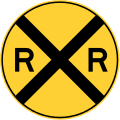
Railroad crossing ahead
R16 Series: Seat Belts and Headlight Use
The MUTCD's R16 series of signs is for seat belt and headlight use related signs. As all situations are not covered, several states have their own standards in addition to the MUTCD.
- Seat Belts and Headlight Use Signs
-

Wear seat belt
-

Lights on when raining
-

Check headlights
-

Turn on headlights
-

Fender bender
Other Local and State Series
The MUTCD does not cover all situations, so states and local governments have developed their own regulatory signs. In these, the sign categories are assigned series either using the MUTCD style, but higher than 16 (as done in Texas), or use a unique series nomenclature system (as done in California).
- Other Local and State Series Signs
-

Obey warning signs state law, Texas
-

Don't block the box, New York City
-

Speed enforced by aircraft sign, California, New Hampshire, Virginia
Schools
The S series of signs is specially designated by the MUTCD for use around schools. Some states have additional school warning related signs in the S series, as well as in the W series of warning signs and/or the R series of regulatory signs of the state supplement or state MUTCD. The MUTCD now requires school warning signs to have fluorescent yellow-green background color.[4]
- Schools
-

School (also used for pedestrian crosswalk near schools) since 2012
-
.svg.png)
School prior to 2012, now obsolete but still can be seen in some areas
-

School speed limit ahead
-

School speed limit when flashing
-

School zone speed limit sign, Arizona
-

End school zone (usually under an R2 speed limit sign)
-
.svg.png)
School bus stop ahead (since 2012)
-
.svg.png)
School bus stop ahead (older version before 2012 revision) but still can be seen in some areas.
-

School bus turn ahead
-
.svg.png)
School bus turn ahead sign, Ohio
Warning
Warning signs are found in the W series of the national MUTCD. They highlight existing conditions, such as a curve, school, dead end street, or traffic signal. They can also warn possible danger such as bumps, bicycles, low flying aircraft, or emergency vehicles. These signs are either yellow or fluorescent yellow in color and, with the exception of a few signs, are usually diamond shaped and sometimes have square or rectangular smaller signs or plaques associated with them. Most W series signs can also be found with orange backgrounds for temporary use in situations such as construction zones. Some of the temporary use signs are only for use in temporary situations.
W1 Series: Curves and Turns
The MUTCD's W1 series of signs is for warning signs relating to curves and turns. As all situations are not covered, several states have their own standards in addition to the MUTCD.
- Curves and Turns
-

Turn (left)
-

Turn (right)
-

Curve
-

Curve with speed advisory
-

Reverse turn
-

Curve out intersection warning
-

Reverse curve
-

Winding road (right-sided variation)
-

Winding road (left-sided variation)
-

Hairpin curve
-

Truck rollover warning
-
.svg.png)
Truck rollover warning with speed advisory, Maryland
-

270 degree loop
-

Pretzel loop, Wisconsin
-

One direction large arrow
-

Chevron alignment
-

Horizontal alignment warning
W2 Series: Intersections
The MUTCD's W2 series of signs is for warning signs relating to intersections including traffic circles. As all situations are not covered, several states have their own standards in addition to the MUTCD.
- Intersections
-

Cross roads
-

Side road at a perpendicular angle
-

Side road at an acute angle
-

T roads
-

Y roads
-

Offset roads
-

Circular intersection warning (traffic circle or roundabout)
-

Traffic circle, alternate
W3 Series: Advance Traffic Control
The MUTCD's W3 series of signs is for warning signs relating to advance traffic controls such as speed limits and signals. As all situations are not covered, several states have their own standards in addition to the MUTCD. The MUTCD provides options for graphic and text signs.
- Advance Traffic Control
-

Stop ahead
-

Yield ahead
-

Speed limit ahead
-

Traffic signal ahead
-

New signal ahead, Michigan
-

Be prepared to stop
-

Speed zone ahead
W4 Series: Lanes and Merges
The MUTCD's W4 series of signs is for warning signs relating to advance traffic controls such as speed limits and signals. As all situations are not covered, several states have their own standards in addition to the MUTCD.
- Lanes and Merges
-

Merge
-

Right lane ends or road narrows from the right
-

Lane drop ahead, Massachusetts
-

Added lane (via merge)
-

Merging traffic
-

Added lane (from entering roadway)
-

Thru traffic merge left, California
-

One lane road or road narrows, New York State
-

Single lane, New York State
W5 Series: Road Width Restrictions
The MUTCD's W5 series of signs is for warning signs relating to road width restrictions. As all situations are not covered, several states have their own standards in addition to the MUTCD. The MUTCD provides options for graphic and text signs.
- Road Width Restrictions
-

Narrow Bridge, current MUTCD version
-

Narrow Bridge, superseded, but still used in some states
-

One lane bridge
-

Narrow winding road, Forest Service USDA
-

Bikeway narrows
W6 Series: Divided Highways
The MUTCD's W6 series of signs is for warning signs relating to divided highways. As all situations are not covered, several states have their own standards in addition to the MUTCD. The MUTCD provides options for graphic and text signs.
- Divided Highways
-

Divided highway
-

Divided highway
-

Divided road
-

Two-way traffic
-

Pass left or right sign, New York State
W7 Series: Hills and Grades
The MUTCD provides several signs in the W7 series dealing with hills and grades. Several states have additional signs for other types of situations not covered by the MUTCD.
- Hills and Grades
-

Steep grade/hill
-

Hill
-

Steep grade/hill percentage
-

Steep grade percentage sign, Idaho
-
.svg.png)
Watch downhill speed, California
W8 Series: Pavement and Roadway Conditions
The MUTCD's W8 series of signs is for warning signs relating to pavement and roadway conditions. As all situations are not covered, several states have their own standards in addition to the MUTCD.
- Pavement and Roadway Conditions
-

Rough road
-

Bump
-

Bumps, Minnesota and North Dakota
-

Rumble strips, New York State
-

Dip
-

Pavement Ends (superseded, but some signs still in use)
-

Road slippery when wet
-

Bike lane slippery when wet
-

Bridge may be slippery, Pennsylvania
- Rocks and Mud
-

Falling rocks, California and Vermont
-

Fallen rock, New York State and Kentucky
-

Falling rocks, Pennsylvania and Hawaii
-

Falling rock, Colorado, North Carolina, Texas, West Virginia
-

Watch for rock, Idaho
-

Rock slide area, California
-

Slides, New York State
-

Slide area, California
- Wind, Fog, and Storms
-

Crosswinds, New York State
-

Dangerous crosswinds, New Mexico
-

High cross winds, Pennsylvania
-

Frequent high winds, Idaho
-

Gusty winds, Wisconsin
-

Fog area, Ohio
-

Occasional blinding dust storms sign, Idaho
-

Severe storm area, Idaho
- Ice and Frost
-

Bridge ices before road
-

Bridge may be icy, Michigan
-

Watch for ice on bridges, Indiana and Texas (as Watch for ice on bridge)
-

Watch for ice, Pennsylvania
-

May be icy, Nebraska
-

Icy, California
-

Frost heaves, Idaho
- Flooding and Water Conditions
-

Flooded, California
-

Subject to flooding, California
-

Roadway subject to flooding, Pennsylvania
-

Road floods during high tide, Hawaii
-

High water, Indiana
-

Water on road, Delaware
W9 Series: Lane Transitions
The MUTCD's W9 series of signs is for warning signs relating to lane transitions. As all situations are not covered, several states have their own standards in addition to the MUTCD.
- Lane Transitions
-

Right lane ends warning sign
-

Lane ends merge left warning sign
-
.svg.png)
Left lane ends, Maryland
W10 Series: Rail and Light Rail
The MUTCD's W10 series of signs is for warning signs relating to rail and light rail. As all situations are not covered, several states have their own standards in addition to the MUTCD.
- Rail and Light Rail
-

Railroad
-

Railroad intersection warning
-

Skewed railroad crossing
-

Light rail crossing, California
-

Light rail crossing, Look both ways, California
-

Low ground clearance railroad crossing
-

Trains may exceed 80 mph
-

Cyclists Dismount To Cross Railroad Tracks, Hemet, California
W11 Series: Advance Warnings and Crossings
The MUTCD's W11 series of signs is for warning signs relating to advance warnings and crossings. As all situations are not covered, several states have their own standards in addition to the MUTCD. The MUTCD allows use of a fluorescent yellow-green background color for signs relating to people crossing the road.[5]
Emergency Vehicles
The MUTCD only provides for a warning of fire stations in the W11 series. Most states have their own signs for other emergency vehicle types which may enter the road.
- Emergency Vehicles
-

Fire station
-

Fire trucks entering when signal flashes, Wisconsin
-

Emergency vehicles, Delaware
-

Texas emergency vehicle sign, Texas
Children
The MUTCD specifies no children related signs in the W11 series. Several states, counties, and municipalities have signs for situations as children at play as well as children with various medical conditions. Some of these signs vary from state to state as there is no federal standard.
- Children
-

Children at play, New York State
-

Deaf child area, New York State, Illinois, Wisconsin, New Jersey
-

Deaf child, Delaware
-

Hearing impaired child, Pennsylvania
-
.svg.png)
Deaf children near, California
-

Blind child area, New York State
-

Blind child, Delaware
-

Autistic child, Ocean County, New Jersey
Bicycles
The MUTCD provides several signs in the W11 series warning of bicycles and for signing bicycle facilities. Several states and localities have their own specific bicycle related signs as well.
- Bicycles
-

Bicycles (a fluorescent yellow-green background may be used with this signs)
-

Share the road, New York City
-

Share the road, Pennsylvania
-
.svg.png)
Watch for bikes, Maryland
-

Share the road, Maryland
-

Bike Lane, San Francisco
Vehicles
The MUTCD provides several signs in the W11 series dealing with vehicles. Several states have additional signs for other types of vehicles and situations regarding vehicles not covered by the MUTCD.
- Vehicles
-

Tractor/farm vehicle crossing
-

Motorcycle crossing, New York State
-

ATV crossing, New York State
-

Golf cart crossing
-

Horse-drawn vehicle ahead, Ohio and other U.S. states
-

Tank crossing, Pennsylvania
-

Truck crossing
-

Watch for stopped trucks, Illinois
Pedestrians, Transit, and Aviation
The MUTCD provides several signs in the W11 series dealing with pedestrians, transit, and aviation. Several states have additional signs for other types of vehicles and situations regarding vehicles not covered by the MUTCD.
- Pedestrians, Rail and Aviation
-

Pedestrian crossing (a fluorescent yellow-green background may be used with this sign)
-

Blind pedestrian crossing, Pennsylvania
-

Ferry crossing, Missouri
-

Balloon launch area, Pennsylvania
-

Low flying planes, New York State
-

Low flying aircraft, Delaware
-

Low flying airplanes cross here, Wisconsin
Animals
The MUTCD provides several signs in the W11 series dealing with animals. Several states have additional signs for other types of animals not covered by the MUTCD.
- Animals
-

Bear crossing (California)
-

Duck crossing (Pennsylvania style)
-

Cattle crossing
-

Deer crossing
-

Ram crossing
-

Equestrians
-

Donkey crossing
-

Sheep crossing
Driveways and Entrances
The MUTCD does not provide signs in the W11 series dealing with driveways and entrances. Many states have their own sign standards dealing with these situations that they place in their own W11 series.
- Driveways and Entrances
-

Hidden driveway
-

Truck entrance, Delaware and Texas
-

Plant entrance, Delaware
-

Theatre exit, Wisconsin
-

Hidden intersection, Delaware
W12 Series: Low Clearances
The MUTCD's W12 series of signs is for warning signs relating to low clearances. As all situations are not covered, several states have their own standards in addition to the MUTCD.
- Low Clearances
-

Low clearance
-

Metric low clearance
-

Clearance
W13 Series: Advisory Speeds
The MUTCD's W13 series of signs is for warning signs relating to advisory speeds. As all situations are not covered, several states have their own standards in addition to the MUTCD.
- Advisory Speeds
-

Speed advisory
-
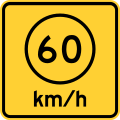
Speed advisory, metric
-

Exit speed advisory
-

Turn curve exit speed advisory, Maryland
-

Ramp speed advisory
-

Curve speed advisory, replaced by MUTCD W13-1
W14 Series: Dead End Streets and No Passing Zones
The MUTCD's W14 series of signs is for warning signs relating to dead end streets and no passing zones. As all situations are not covered, several states and local governments have additional signs for other types of situations not covered by the MUTCD.
- Dead End and Limited Access Streets
-

Loop street, Pennsylvania
-

No thru street, Pennsylvania, Texas
-

No Outlet
-

Dead End
-

Dead End, New York City
-

End, New York City
-

Road ends, Missouri and Texas
-

No Passing Zone
-

Zona De No Pasar (No Passing Zone), Puerto Rico
W15 Series: Playgrounds
The MUTCD's W15 series of signs is for warning signs relating to playgrounds. As all situations are not covered, several states have their own standards in addition to the MUTCD.
- Playgrounds
-

Playground (a fluorescent yellow-green background color may be used for this sign)[1]
- ^ "2009 Edition Part 2 Figure 2C-11. Non-Vehicular Warning Signs". Manual On Uniform Traffic Control Devices. United States Department of Transportation. Retrieved 6 June 2012.
W16 Series: Supplemental Plaques
The MUTCD's W16 series of signs is for supplemental plaques for warning signs. As all situations are not covered, several states have their own standards in addition to the MUTCD.
- Supplemental Plaques
-

Steep hill, Delaware
-

Fire house (used in conjunction with graphic fire station sign), New York State
W17 Series: Speed Humps
The MUTCD's W17 series of signs is for warning signs relating to speed humps. As all situations are not covered, several states have their own standards in addition to the MUTCD.
- Speed Humps
-

Speed Hump
W19 Series: End of Controlled Access Highway
The MUTCD's W19 series of signs is for warning signs relating to the end of a controlled access highway. As all situations are not covered, several states have their own standards in addition to the MUTCD.
- End of Controlled Access
-

Freeway Ends, 1 Mile
-

Expressway Ends, 1 Mile
-

Freeway Ends
-

Expressway Ends
-

All traffic must exit
W20 Series: Work Zones
The MUTCD's W20 series of signs is for warning signs relating to work zones. These signs are typically orange background ones used for temporary situations. As all situations are not covered, several states have their own standards in addition to the MUTCD.
- Work Zone Signs
-

Road Work Next 5 Miles
-

Road Work Ends
-

Work Zone for Speed limit
-

Road work ahead
W21 Series: Road Work
The MUTCD's W21 series of signs is for warning signs relating to road work. These signs are typically orange background ones used for temporary situations. As all situations are not covered, several states have their own standards in addition to the MUTCD.
- Road Work Signs
-

Flaggers in road ahead
-

Workers in road ahead
-

Fresh oil on road
-

Utility work in road
W22 Series: Blasting Zones
The MUTCD's W22 series of signs is for warning signs relating to blasting zones. These signs are typically orange background ones used for temporary situations. As all situations are not covered, several states have their own standards in addition to the MUTCD.
- Blasting Zone Signs
-

Blasting zone ahead
-

Turn off 2-way radios and cell phones
-

End blasting zone
W23 Series: Slow Traffic
The MUTCD's W23 series of signs is for warning signs relating to slow traffic. These signs are typically orange background ones used for temporary situations. As all situations are not covered, several states have their own standards in addition to the MUTCD.
- Slow Traffic Signs
-

Slow traffic ahead
-

New traffic pattern ahead
W24 Series: Lane Shifts
The MUTCD's W24 series of signs is for warning signs relating to lane shifts, where traffic I'd diverted slightly toward the left or right of the roadway, but the route is otherwise unchanged. These signs are typically orange background ones used for temporary situations. As all situations are not covered, several states have their own standards in addition to the MUTCD.
- Double Reverse Curve Signs
-

Single Lane Shift Pair
-

Double Lane Shift Pair
-

Triple Lane Shift Pair
-

All lanes
W25 Series: Oncoming Traffic Has Extended Green
The MUTCD's W25 series of signs is for warning signs oncoming traffic having an extended green signal at a traffic light. As all situations are not covered, several states have their own standards in addition to the MUTCD.
- Extended Green Signs
-

Extended green
-

Possible extended Green
Miscellaneous
The MUTCD does not provide signs dealing with some other road and highway situations. Many states have their own sign standards dealing with these situations.
- Miscellaneous
-

Tunnel
-

Restricted weight bridge, New York State
-

Underpass, New York State
Guide
Guide signs include highway route markers (shields), street signs, mile markers, and exit signs.
Interchange signs
- Interchange Advance Guide Signs
-

Interchange advance guide, New Jersey
-

Interchange advance guide, New York State
-

Interchange advance guide, Hawaii
-

Interchange advance guide, California
- Interchange Exit Direction Signs
-
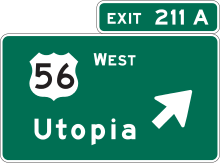
Interchange exit direction
-

Interchange exit direction, Maryland
-

Interchange exit direction, Virginia
-

Interchange exit direction, New York State
-

Exit number sign, right
-

Exit sign, right
-

Exit number sign with speed advisory
-

Mileage signs for highway routes, Colorado
- Toll Road Signs
-

Toll road pass only
-

Toll road pass or HOV 2+
-

Toll costs at intersections or HOV 2+
- Logo service and Rest Area signs
-
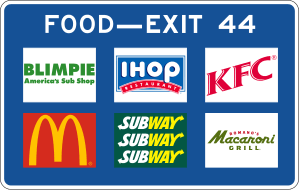
Specific service signs for food, gas, lodging, etc.
Shield markers
- Guide Signs and Route Markers (Shields)
-

Single-digit interstate route shield
-

Two-digit interstate route shield
-
.svg.png)
Single-digit interstate route shield, California
-
.svg.png)
Three-digit interstate route shield
-
.svg.png)
Three-digit interstate route shield, California
-
_Metric.svg.png)
Four-digit interstate route shield, Hawaii
-

Off-Interstate Business Loop Route shield
-

Off-Interstate Business Spur route shield
-

Single-digit U.S. route shield
-
.svg.png)
Two-digit U.S. route shield
-

Three-digit U.S. route shield
-

Single-digit state route shield
-

Two-digit state route shield
-

Three-digit state route shield
-

Single-digit state highway shield, Mississippi
-

Two-digit state highway shield, Mississippi
-

Three-digit state highway shield, Mississippi
-

Michigan State Trunkline single-digit shield
-

Michigan State Trunkline double-digit shield
-

Michigan State Trunkline triple-digit shield
-

Two-digit state highway shield, Oklahoma
-

Three-digit state highway shield, Oklahoma
-

Two-digit state route shield, South Carolina
-

Three-digit state highway shield, South Carolina
-
.svg.png)
Single-digit U.S. route shield, California
-
.svg.png)
Two-digit U.S. route shield, California
-
.svg.png)
Three-digit U.S. route shield, California
-
.svg.png)
Historic Route, U.S. Highway shield, California
-

Two-digit state route shield, Alabama
-

Three-digit state route shield, Alabama
-

Single-digit state highway shield, Arkansas
-

Two-digit state highway shield, Arkansas
-

Three-digit state highway shield, Arkansas
-

Four-digit state highway shield, Arkansas
-

Two-digit state highway shield uses a keystone, Pennsylvania
-

Three-digit state highway shield uses a keystone, Pennsylvania
-

Single-digit state route shield, New York
-

Two-digit state route shield, New York
-

Three-digit state route shield, New York
-

Four-digit state route shield, New York
-

Reference route marker, New York
-

Two-digit state route shield, Ohio
-

Three-digit state route shield, Ohio
-

Two-digit state route shield, California
-

Three-digit state route shield, California
-

Three-digit state route with toll shield, Florida
-

Single-digit state highway shield, Florida
-

Two-digit state highway shield, Florida
-

Three-digit state highway shield, Florida
-

Four-digit state route shield, Florida
-

Two-digit county route shield
-

Three-digit county route, shield New Jersey
-

Farm-to-market road shield, Texas
-

Missouri supplemental route shield
-
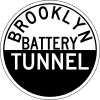
Brooklyn Battery Tunnel shield
-

New Jersey Turnpike shield
-

Ohio Turnpike shield
-

Dallas North Tollway shield
-

Eisenhower Interstate System sign
-

Palisades Interstate Pkwy Shield
Note: State markers are illustrative examples; all states may select their own marker shapes or use the default circle. See Numbered highways in the United States#State highways and other similar systems.
- Street Name Signs
-

Street name sign, MUTCD D-3
-

Street name sign, MUTCD D-3
-

NYC Broadway street name sign
-

NYC street name sign
-

NYC Midtown Manhattan street name sign
-

NYC Historic district street name sign
-

Chicago street name Sign
-

Boston street name sign
-

Washington, D.C. street name sign
-

Philadelphia street name sign
-

Hoboken street name sign
-

Los Angeles street name sign
-

Minneapolis East-West street name sign
-

Minneapolis North-South street name sign
-

Minneapolis Arterial street name sign
Toll Road Signs
Chapter 2F of the MUTCD deals with signs for toll roads.
- Toll Road Signs
-

MUTCD Conventional Toll Plaza advance sign
-

MUTCD Conventional Toll Plaza advance sign
-

New Jersey Turnpike E-ZPass toll booth sign
Hospital
Non-compliant to MUTCD Signs
There are many signs that are non-compliant to MUTCD and/or state MUTCD standards seen in use on public and semi-public roads.
- Non Compliant vs Compliant Signs
-

Non-standard US 20 West sign, Main St. after Lexington St., Waltham Center, MA
-

Standard US 20 West sign
-

No parking sign with permissive parking green color, Glenside, PA
-

Standard no parking sign
-

Greene County Route 16 sign in Catskill / Adirondack colors, Hunter, NY
-

Standard Greene County Route 16 sign
| Wikimedia Commons has media related to Road signs in the United States. |
- ↑ Staff (September 19, 2011). "Who Uses the MUTCD? And How?". Federal Highway Administration. Retrieved March 16, 2012.
- ↑ Staff. "The Shape—and Color—Give Us a Sign". Federal Highway Administration. Archived from the original on April 1, 2009. Retrieved April 5, 2009.
- 1 2 3 Staff (October 2011). "Chapter 7: Parallel Parking". Driver's Manual and Study Guide. New York State Department of Motor Vehicles. Retrieved March 16, 2012.
- ↑ "2009 Edition Chapter 7B. School Signs". Manual on Uniform Traffic Control Devices. The United States Department of Transportation. Retrieved 6 June 2012.
- ↑ "2009 Edition Part 2 Figure 2C-11. Non-Vehicular Warning Signs". Manual on Uniform Traffic Control Devices. United States Department of Transportation. Retrieved 6 June 2012.


